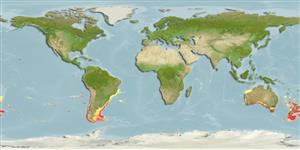Preferred temperature (Ref.
123201): 3.3 - 12.7, mean 7.2 °C (based on 279 cells).
Phylogenetic diversity index (Ref.
82804): PD
50 = 0.5156 [Uniqueness, from 0.5 = low to 2.0 = high].
Bayesian length-weight: a=0.00219 (0.00131 - 0.00364), b=3.17 (3.02 - 3.32), in cm total length, based on LWR estimates for this species & (Sub)family-body (Ref.
93245).
Nível Trófico (Ref.
69278): 4.2 ±0.76 se; based on food items.
Generation time: 11.0 (8.6 - 12.6) years. Estimated as median ln(3)/K based on 10
growth studies.
Resiliência (Ref.
120179): Baixo, tempo mínimo de duplicação da população 4,5 - 14 anos (K=0.1-0.23; tmax=30; tm=5-7).
Prior r = 0.25, 95% CL = 0.16 - 0.37, Based on 4 full stock assessments.
Fishing Vulnerability (Ref.
59153): Very high vulnerability (84 of 100).
🛈
Climate Vulnerability (Ref.
125649): Moderate vulnerability (44 of 100).
🛈
Nutrients (Ref.
124155): Calcium = 11.8 [7.2, 25.7] mg/100g; Iron = 0.365 [0.190, 0.713] mg/100g; Protein = 15.6 [13.6, 17.7] %; Omega3 = 0.255 [0.136, 0.502] g/100g; Selenium = 31.6 [14.3, 70.0] μg/100g; VitaminA = 6.94 [1.54, 32.25] μg/100g; Zinc = 0.234 [0.157, 0.351] mg/100g (wet weight); based on
nutrient studies. 